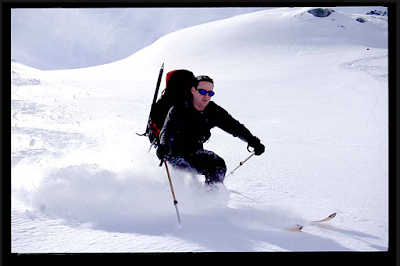A long-ago conniption raises live questions about the state of mountain writing
It’s safe to say that this mid-Victorian Englishman did not enjoy his sojourn, one wet summer during the 1870s, in a fog-bound Swiss mountain hotel. When writing up the experience, he dipped his pen in acid to sketch out grotesque caricatures of his fellow guests and countrymen. Businessmen on holiday, clergymen, matrons, spinsters – all are ruthlessly lampooned.
 |
English "Alpine Clubbists" at Grindelwald, c. 1900
Artist unknown. |
But the scholar’s most corrosive grade of bile was reserved for the “Alpine Clubbist”. The mountaineer “is not an imaginative man,” the writer sneers. Instead, he is a bit of a gear freak (“His one grief in life seems to be the failure of his new portable cooking apparatus …) with social skills to match: “Alpine talk is the lowest variety of conversation as the common run of Alpine writing is the lowest form of literature.”
And then we hear the mid-Victorian intellectual work himself up into a screech of exasperation as he piles into the quality of that literature:
What is it which makes men in Alpine travel-books write as men never write elsewhere? What is the origin of a style unique in literature, which misses both the sublime and the ridiculous, and constantly hops from tall-talk to a mirth feeble and inane? Why is it that the senior tutor, who is so hard on a bit of bad Latin, plunges at the sight of an Alp into English inconceivable, hideous? Why does page after page look as if it had been dredged with French words through a pepper-castor? Why is the sunrise or the scenery always "indescribable," while the appetite of the guides lends itself to such reiterated description? These are questions which suggest themselves to quiet critics, but hardly to the group in the hotel …
These were the criticisms that were suggested by one John Richard Green in his
Stray Studies from England and Italy, a travel journal published in 1876 (the remarks quoted are from the chapter entitled “
Hotels in the clouds”).
Had J R Green not been one of the era’s most prominent historians, the Alpine Clubbists could probably just have shrugged. But, finding themselves attacked by the Niall Ferguson of their day, they doubtless felt obliged to respond. Appropriately, this duty fell to Douglas Freshfield, himself a prolific alpinist and mountain writer. His riposte appeared in the seventh volume of the Clubbists’ own
Alpine Journal, in the same year as Green’s tirade.
Like the lawyer he was between mountaineering forays, “DWF” opens his defence by redefining the terrain. The
Alpine Journal itself and its predecessor,
Peaks, Passes and Glaciers, were only ever intended for an “inner public”, he writes. Thus, “it would be preposterous to select [them] as by themselves fair representatives of our literature, and no competent and candid critic would venture on such an absurdity.”
Then he moves to the offensive: “we are ready to submit Alpine writing to a comparison with any portion of the larger literature of travel of which it forms a division” – although he does not deny that the Alpine Club also includes a “sporting element” whose productions “may not bear examination by any high literary standard”.
As for Green’s charge that most alpine writing “misses both the sublime and the ridiculous”, DWF raises the ingenious excuse that many mountaineering authors might wish to avoid courting ridicule by attempting to rival “Mr L Stephen’s description of a sunset from Mont Blanc, or Professor Tyndall’s of that seen on the spurs of the Weisshorn”.
The reference here is to John Tyndall’s
Hours of exercise in the Alps and Leslie Stephen's
Playground of Europe, both published in 1871. DWF might also have mentioned Edward Whymper, who in the very same year came out with his
Scrambles Amongst the Alps in the Years 1860-69. But Whymper’s relationship with the Alpine Club was always an edgy one, which may explain why DWF passed over him in silence.
With the benefit of a century and more’s worth of hindsight, DWF can be seen to have won his case handsomely. While Green’s works have sunk almost without trace, those of Tyndall, Stephen and, yes, Whymper have stood the test of time – or, at least, they are still regularly read and reprinted. (There were never any hard feelings, by the way, between the Clubbists and the eminent historian: Leslie Stephen later edited J R Green’s collected correspondence.)
So, case closed? Well, not quite. Long after this mid-Victorian debate, mountain writers have continued to sound a defensive note. “Time has gone on; and the discontent with mountain publications seems to be repeating itself,” admitted Geoffrey Winthrop Young in 1955 ("
Courage, and mountain writing").
Two decades later, Michael Ward was hardly more sanguine: “In general, mountain literature is rich and varied within the bounds of a subject that tends to be esoteric. It is not easy to transpose great actions into good, let alone great literature.” ("
Mountain literature – then and now",
Alpine Journal 1976).
Might it be then that J R Green was on to something with his diatribe back in 1876? Douglas Freshfield certainly thought so. “Caricatures … have a value,” he wrote in his reply to Green, “and especially for their subjects. Having faced the attack, we may do well to consider how we may render its repetition impossible. Let us all bear consistently in mind the faults of which we are here accused…”
Reference
Illustration is from Gabriele Seitz,
Wo Europa den Himmel berührt: die Entdeckung der Alpen, Büchergilde Gutenberg, 1989.





